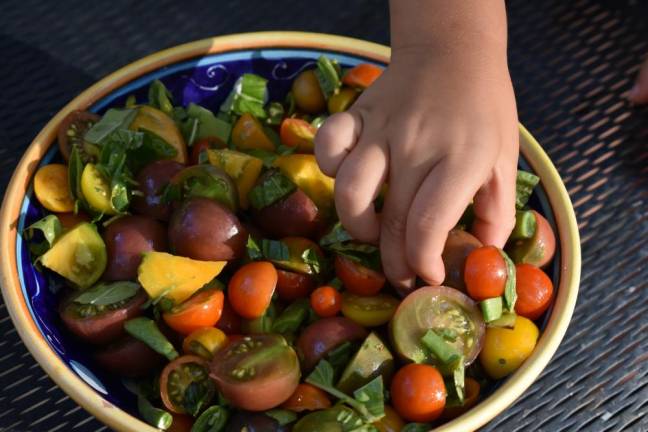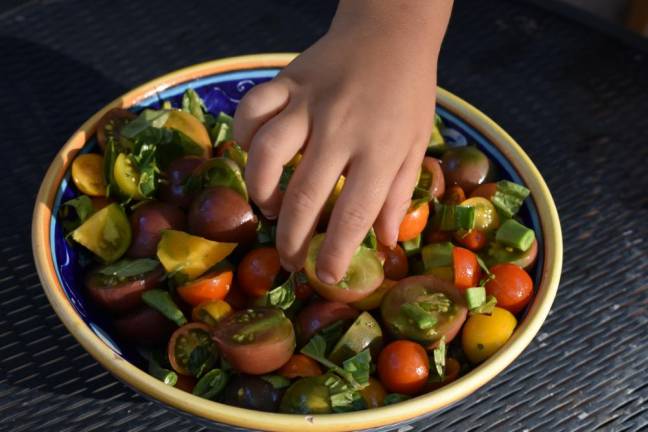The wilds of garden three


The kids and I came home from the Adirondacks at summer’s end – where I’d been daydreaming of rows of juicy Goldie tomatoes awaiting my return – to a rather apocalyptic vision. The gardens, which should have been at peak glory, looked hardscrabble and dried up, the scant tomatoes on my stunted vines mostly blighted by end rot. Husband Joe had been watering twice a day, too. Maybe it was the heat, or the lantern flies – those pretty devils I’d been hearing about but never laid eyes on until all of a sudden they were everywhere, camped out all over our grapevines. The bunny that had been getting in, leaving telltale droppings, probably didn’t help either.
Our goal is to put up 52 quarts of tomatoes, one to use each week for pasta sauce, pizza, stew, shakshuka. That wasn’t going to happen.
Stepping gingerly around desiccated vines, my thoughts turned to my farmer-friends. Was this a blip that a couple good rains would make right, or the beginning of the great unravelling? Who could know. A grim wave of relief washed over me that husband Joe and I were not (as I sometimes daydream) both farmers, our income dependent on the harvest. He’d had a rough egg year, too, and while we were away he’d culled most of the older laying hens, aiming to start fresh with the up-and-coming young flock. But as I poked around in the sad-looking shambles, I saw that there was some food in there. It wasn’t the glamorous paragons of the victory garden, but here and there among the scratchy stems of fallen comrades, hardy survivors were soldiering along.
The potatoes had done their unassuming thing, keeled over and now filled our bushel baskets, coming up easily out of the dust, no shovel required. And the “world’s tiniest” spoon tomatoes, whose seeds I’d bought as a novelty, ignoring Joe’s objection that they were too insubstantial to be worth the effort of harvesting? Their leaves had filled out lacy and gorgeous, spilling into the empty spots left in the garden (and yes, our hearts) by their moribund big sisters. Best of all, my nine-year-old, the most “discerning” of my eaters, has declared spoon tomatoes her favorite vegetable. I don’t care that they’re actually a fruit, or that they’re the size of a pea. I’m calling it a win. These, my drought-year MVPs, have endured their way into a special category. Through their resilience, they have secured themselves a spot in next year’s garden and, who knows, may end up an ancestral food of my great-grandchildren. If only I can remember what exactly it was I’d planted. What, for instance, was that tree-looking thing that I sowed an entire row of? Whatever it was looked happy, its deep green standing out in stark contrast against its washed out, half-dead surroundings, its flowers just beginning to plump into fruit when everything else seemed intent on finishing up its life cycle in a particular hurry. I poked around on the three sites I’d ordered seeds from. Aha, dwarf tamarillo, a South American native that can grow six feet tall and in warm climates is, in fact, a tree! Whose fruit, I realized only now, may or may not have time to mature in this Northeastern climate into the golden-orange hint-of-pineapple flavor that had caught my fancy back in January when I was stuck home with Covid and a pile of seed catalogs.
But tamarillos or no, the season has already been salvaged by another surprise producer. This year’s dark horse did not come out of any of the beds that I toiled over from the moment the soil began to ponder thawing. Of course not. That distinction goes to a neglected swath of scrubland that I never actually got around to planting.
Garden three, let me explain, is enormous. Joe inherited a bunch of wire fencing from a neighbor and decided, apparently, to use it all, encircling perhaps a half-acre of poison-ivy infested no-man’s-land that we’d half-assedly reclaimed in our bitter forever war with Japanese barberry. We put the goats there over the winter, feeding them scraps and hay, the chickens coming by to peck around and scratch in the leaves we heaped in there for bedding.
What happened next feels right out of a fairytale of the Jack and the Beanstalk subgenre. A jungle of tomato and squash vines emerged from the leaf duff, punctuated by the occasional ground cherry. Untended, unwatered, it spread its tentacles, clambering up the fence and back down, willy-nilly, into the chicken yard, into the people-yard, over the young fruit trees. Oblivious to the drought, the lantern flies and the bunny, the vining mass has deposited untold dozens of squash – butternut, cucuzza, pink banana jumbo – and a few diminutive pumpkins in its wake, whose numbers I can only guess at for now.
But the tomatoes. The tomatoes. The queen of the garden lives! They’re mostly cherries, a riot of shapes and colors, from purple-black to sunshine-yellow to tiger-striped red and orange. Harvesting them has its hazards, both because there’s nowhere to put your feet and because there’s poison ivy in there. But the reward – a tomato salad that glimmers with a dash of olive oil and all the colors of the end of summer – is a gift we’d all but given up on, a bequest from the enigmatic wilds of garden three.